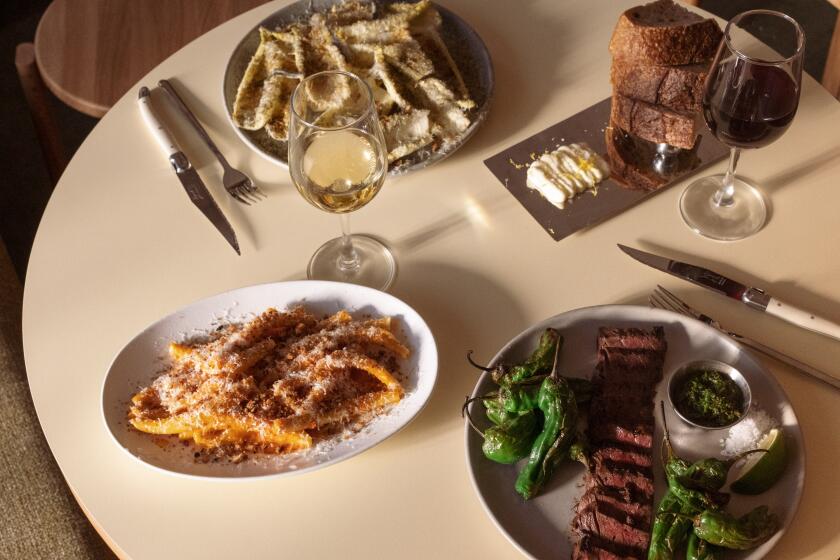The oranges that enraptured a millionaire
Editor’s note: This article was originally published in Slake in February 2011
Visitors to the Norton Simon Museum, the collections jimmied into the corpse of the former Pasadena Art Museum, come to admire the handsome Frank Gehry garden, the shimmering tiles by Edith Heath, and what is probably the most impressive group of Rembrandt paintings on the West Coast. There are Degas ballerinas by the bushel, Rubens by the acre, and Venetian cityscapes sufficient to decorate the parlor of any 18th-century earl. Simon, or his consultants, had a decent eye – his Cranach looks like a Cranach, and the Ingres portrait is really fine. There may not be much competition, but the Simon is probably the best small art museum in California, and as much as one personally might mourn the superb contemporary-art museum that was vaporized to accommodate the catsup millionaire’s dream, as a fact on the ground the Simon is admirable.
But a casual visitor, someone there because her guidebook tells her that she should come have a look at the Van Gogh, may be understandably puzzled by what seems to be the institution’s emphasis on Still Life with Lemons, Oranges and a Rose by Francesco de Zurbarán, a 17th-century Spanish painter who was unlikely to have come up in the Renaissance art survey course she took as an elective sophomore year. The museum’s gallery map features the Zurbarán on its cover, and the gift shop is stocked with replicas of the painting in every possible size and form. It was the star of the small Norton Simon exhibition in New York’s Frick last year. More to the point, the Norton Simon’s galleries are laid out in a way that makes it almost impossible to avoid, a flash of yellow in a room just off the most glamorous corridor, a magnetic yellow positioned to distract you as you rush toward the Botticelli.
When Simon bought the painting in the early ‘70s, it was the third-most expensive Old Master ever sold, a stand-in for the Velazquez that would never hit the auction block, and the $2,725,000 cost figured into the allure of what is, after all, a picture of some fruit. Zurbarán, the painting’s author, was a friend of Velazquez and an admirer of Caravaggio; his work, chiefly pious religious scenes painted for his court patrons in Seville, is often compared favorably with them both. If you are an aficionado of the way a saint’s loose, white robe puddles around his holy ankles, Zurbarán is the Baroque-era painter for you.
But Still Life is charismatic for a picture of fruit, a three-part composition of nipply lemons, oranges, and an untouched cup of water positioned on a silver tray. An oddly specific light illuminates the composition, early morning sun perhaps, streaming through a window above and to the viewer’s left, sharply focused enough to render the left face of the oranges bright, washed out, although the shadows are almost black. The wooden table on which they sit appears to receive barely enough light to do a crossword puzzle by. To the right of the oranges, the sunlight glints from the rim of a porcelain drinking cup filled with water; a white rose stained pink at its edge glows softly as if illuminated from within. On the left are four lemons: some are as defined by their sunken areoles and proud nipples as a vintage Playboy centerfold; another, in the foreground, appears to have the outline of a face with a jutting, crooked nose. If you squint, it is almost a match for the head of the leathery crone who cradles the newborn Virgin in another Zurbarán painting mounted a few feet to one side. The rough-skinned oranges are heaped in a finely woven basket and wreathed with an arrangement of dark leaves and virginal white blossoms that seem less to grow from the fruit than to have descended from heaven.
The museum abounds in other fruit-filled still-lifes of the era, and they thrum with life, the yellowing edges of leaves signifying decay, the lumps and hollows hinting at sweet temporality, even the turnips and loamy potatoes that look like tomorrow’s dinner. Ants, butterflies, worms, beetles skitter along the edges of the displays, nibbling, sucking out juice.
Fruits are pure sex, the naked reproductive organs of a tree: juicy, plump with fertility, cleft with alluring, syrup-crusted fissures. When we look at Chardin’s cherries or a Cezanne peach, what we see is possibility. What we see when we look at Zurbarán’s citrus may be the opposite of that – this is among the chastest damned fruit in existence; unviolated ornamental fruit meant to be admired rather than eaten. There are no crumbs. Not a bite is missing. The lemons are actually citrons, whose rind is fragrant but whose flesh is all but inedible; the oranges, like most in Seville at the time, are almost certainly bitter. These will never be eaten.
In fact, he mostly hides the naughty bits as completely as Raphael does the genitals on his half-robed saints – except for a solitary, lovingly rendered crater, the stem end of the forward most of the oranges, at the mathematical center of the painting and thrust out quite directly at the viewer, the pucker at the center of the world. Centered between the virginal chalice on the one hand and the voluptuous citrons on the other, the dark, bottomless, pucker invites what is sometimes known as the male gaze.
The saintly glow of the fruit is indistinguishable from the one on the face of Zurbarán’s St. Francis on the painting next to this, or rather to that on the skull to which the saint kneels. There are no glints of light on the oranges themselves, no shine, just brilliantly rough surface. The fruit has no physical presence – it is impossible to imagine plucking it from its basket, to smell it, to feel the heaviness of its juice in your palm, but you want to, you ache for sensation, driven by its sheer, pornographic unavailability. It is no wonder Zurbarán’s oranges enraptured a millionaire.
You don’t want to eat this fruit. You want to f🍋ck it.
More to Read
Eat your way across L.A.
Get our weekly Tasting Notes newsletter for reviews, news and more.
You may occasionally receive promotional content from the Los Angeles Times.











